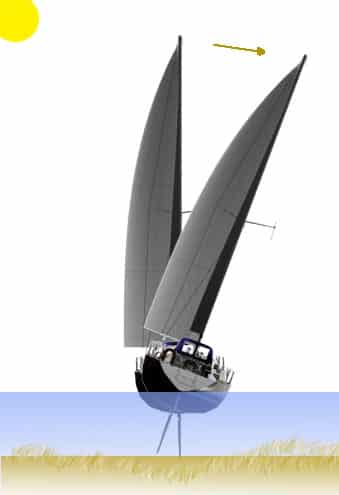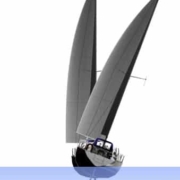Running Aground
In the information age, running aground is usually caused by an amateur mistake, and besides the potential damage, it is also highly embarrassing. A common error in thinking (or not thinking) is using an electronic chart with the zoom level too far out for the screen to display a low-water area.
But, don’t be too embarrassed…The truth is that there are 2 different types of sailors: those who have run aground, and those who haven’t run aground YET. |
Should the grounding cause you to be stuck, such as into a mud bottom, you may have difficulty getting off. If there is a rising tide, you may decide to wait it out. However, if the tide is going out you need to work fast to get loose.
To get out of your predicament use any combination of the following:
- Luff the sails to stop the driving force.
- Use the engine to try to back off.
- If you cannot back off, put the wheel or tiller hard over and use power to turn the boat around. It should screw around fairly easily with the keel as the pivot point.
- Heel the boat over by putting all the crew to one side. Leaving the sails up can also aid in heeling the boat. Heeling will effectively lift the keel up enough to get you unstuck.
- Kedging: Once turned around, walk the anchor out into deeper water in the direction you came from. Haul in on the anchor with a winch. You may need to use flotation to swim the anchor out farther.
The use of engine power may help, depending upon the bottom materials holding the vessel. Having someone go under the vessel to determine the cause is tricky and should not be done by inexperienced personnel. Make certain the engine is turned off anytime someone is in the water around or under the vessel. Use the engine to try to back off. If that does not work, put the wheel hard over and use power to turn the boat around.
For boats that have a straight keel, it can be very successful to simply heel the boat over by putting all the crew to one side. Leaving the sails up can also aid in heeling the boat. Heeling will effectively lift the keel up enough to get you unstuck. The following diagram shows this principle. However, you should not attempt this on boats with keels that have a winged bottom. You can do serious bending damage to the keel wing. Nor should you do this with boats that have dual rudders (one on each side).

When chartering a boat it is prudent and ethical to report any grounding. If you’ve caused damage you may be endangering the next charter group’s lives.







